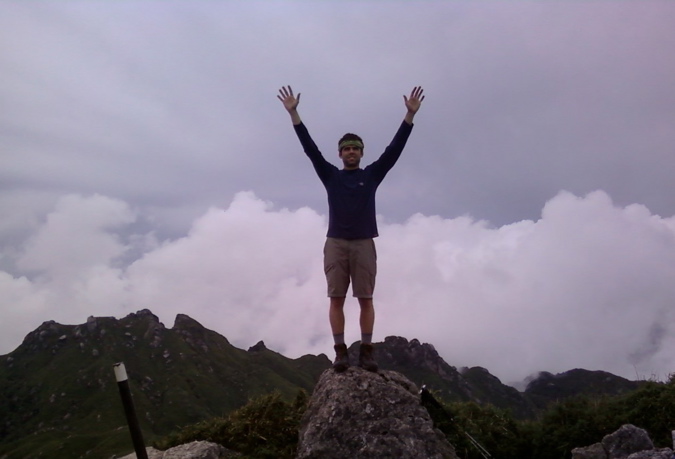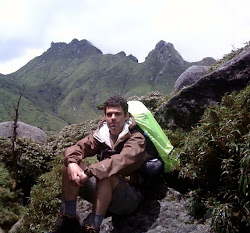

I finally got all the photos from Sandra, so now to post a blog about my trip to the wonderful island of Yakushima! It truly is a great place, but shhh, don’t tell anybody about it or it might get spoiled. Seriously, it is a popular destination for Japanese tourists, and some of the trails to the more famous spots can get congested during the peak seasons; but even so the island is far from being overrun by sightseers. And it’s not built up and uglified, either, which to me seems hardly short of a miracle given the vast natural beauty of the place. The few large hotels on the island are neither obtrusively in the villages (the biggest of which is still small) nor fronting the seashore; whether by chance or regulation they are safely tucked away somewhere out of direct eyesight. There is some industry and related facilities but their scale seemed relatively small.

The mountains and forests are by far the largest and most obtrusive (in the best possible way) things on the island, complete with many little Yakushima deer, macaques (small monkeys), and of course the famous yakusugi trees. These are huge, ancient trees in the cypress family. The oldest generation of these trees is revered by the Japanese. Each is over 1,000 years old and each has its own name. There are probably several hundred that have survived the logging of past periods. The oldest and largest, “Jomon sugi”, is 25 meters tall, has a circumference of 16.4 meters and is between 2,600 and 7,200 years old. I saw this yakusugi on the second day of our backpacking excursion, which I’ll recount shortly. Most of the yakusugi are about half Jomon sugi in all statistics except height.
Jomon sugi
Besides the mountains, which are the most impressive draw of the place, there is the seashore surrounded by coral and a few small sandy beaches. The vegetation goes right down to the oceanside in many places, and especially in the south there are many tropical plant species such as palm trees and mangroves. (We even checked out a huge outdoor garden, which was looked more like a conservatory except they harvested the tropical fruits. We got to sample some exotic fruits there.) Despite the seemingly small area of the sandy beaches, Yakushima still manages to serve as a hatching grounds for a large number of sea turtles. This is one thing I didn’t get to see, but our time was short and we couldn’t do everything.
Shin-takatsuka mountain hut
We found out that it takes a lot of work to see the most beautiful sights in Yakushima. The trail left us sore and we decided to shorten our backpacking trip from three to two days (actually a little more than two because we had to hike out a few kilometers on the third day). We did quite a hike on the first day with full packs and by the time we got to Jomon sugi night was falling (photo above, almost too dark to see). We were almost too exhausted to appreciate how impressive the tree was. However, during the first part of the day we got to see plenty of hardly less impressive trees while we were still fresh.
It rains a lot on Yakushima, and while this can be inconvenient for hiking and outdoor activities, it is also the cause of much of the beauty found on the island. Within the jungle, trees and rocks are covered with moss and small plants of various hues and textures, and during a leisurely amble through the forest one can feel entranced by the magical environment. The trees seemed to speak to me, telling me to imitate their peace and self-assurance and teaching me the way to live and thrive in the world. I hope I will remember to heed their call.
View from near Miyanoura dake
If the first day was the day to experience the enchantment of the forest, the second day lent itself to impressive mountain views. On this day, after a dry and comfortable night in a mountain hut (the huts are free to use and prevent people from having to pitch tents, thus reducing the environmental impact) we broke out of the tree line into an elevated area of shrubs and dwarf-size trees, ascending eventually to Miyanoura dake, a rocky peak at an elevation of about 2,000 meters.
Yakushima is simply bristling with steep mountains and flung with boulders like a pebbly hedgehog. On a clear (or clear-enough) day this makes for great views and photos. The mountains seem to be most often covered with clouds and fog, so we were lucky to have some visibility during our trek. At the top of Miyanoura dake, we were scolded by some Japanese hikers for having set our packs down on some grass. They managed to inform us in broken English that there are many mountain flowers that grow there and that we should place our packs (and feet) on the rocks only. We heated up our lunch of ramen, feeling grateful for the vista and for having been enlightened in the matter of the delicate mountain flora.
Hana-no-ego highland marsh
On the third day (Wed), we woke up in the early morning to a deluge of rain beating the cabin roof and the ground outside. We had the hut (according to the guidebook with a capacity of 60) practically to ourselves, presumably for the rainy forecast. Eventually, all suited up, we navigated the final 1.5 kilometers of trail to the road. Two kilometers further on was the bus stop. It rained practically all of that day and the next. We had scheduled our hike well. The rest of the day was taken up by riding several buses back to Miyanoura village, where we had left a bit of extra luggage, and doing some much-needed laundry.
Camping at Yakushima Youth Travel Village near Kurio
The following morning we rode the bus to the other extreme of the island (the southwest), near a small village called Kurio, where we intended to spend our remaining few days. We decided to camp out at Yakushima Youth Travel Village, a friendly and accommodating place; the only downside being that it is sort of out-of-the-way. It is in a beautiful spot and near the island’s most famous waterfall, but it’s not the most convenient location for getting food, etc. However it suited us and we enjoyed two days there, exploring the seashore, Oko-no-taki waterfall (88m high, photo below) and the outdoor fruit garden, and relaxing in an onsen, a natural seaside hot spring (see photo below).
On Saturday we decided to take the bus from Kurio early in order to catch the 12:00 ferry back to Kagoshima (where we had to fly out from on Sunday morning) so we would have a bit of time to explore there. However, we had a couple of hours of extra time in Miyanoura before the ferry left, and I knew just the thing. On Thursday morning before leaving for Kurio, I had stumbled upon a nice coffee shop searching for breakfast. It was a place with music, plants, good coffee and food, and some uniqueness to it. So I convinced Sandra to go there with me on Saturday. The coffee was good. The jalapeño pizza hit the spot. And the ginger ale was dry and real. I was happy.
Oko-no-taki waterfall
The final thing worthy of a mention on the trip was the few hours we spent in Kagoshima Saturday afternoon and evening. After checking-in to our guesthouse, we took another, very short ferry to Sakurajima, an almost-island with an active volcano. There are several good hot springs there, and we spent several hours relaxing in one of them. I think I really needed it after running around Yakushima. This onsen was a little less rustic and also larger than the one in Yakushima, but it was still a very natural setting, being as it was all constructed with local stone, tucked at the base of a cliff, towered over on the cliff side by a huge mangrove tree, and literally at the edge of the ocean.
Mangrove tree near Yakushima Fruit Garden
Despite the fact that I was very active during almost the whole trip, I still returned feeling refreshed, having been away from the classroom and distracted and enriched by other, fulfilling activities. Now I feel quite ready to complete my final 2 ½ months here. The next thing, which I am already contemplating, is what kind of a break to take when I finish my year, and also what to do next. I will be posting about this, I hope, in the near future. Until then, take care all!

Seaside onsen






















